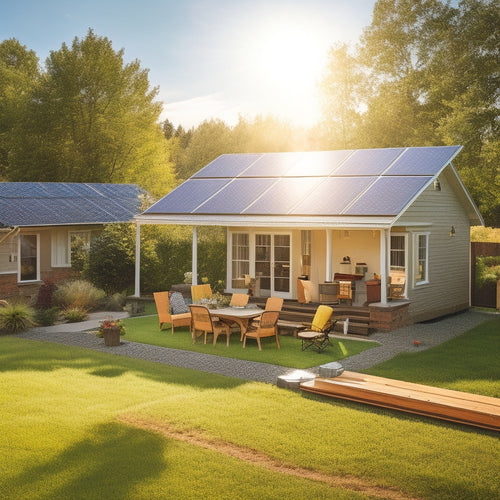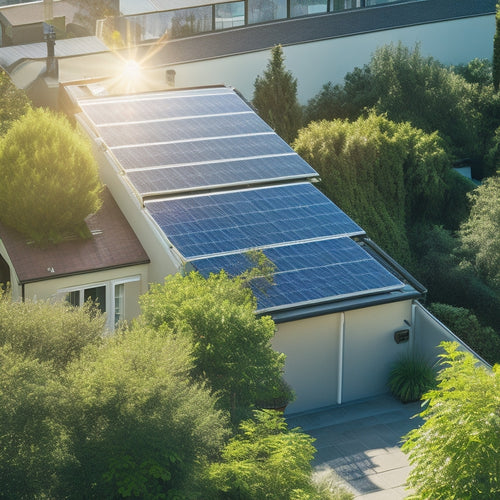
A Beginner's Guide to Solar Panels and Green Energy Savings
Share
As you begin your expedition to utilize the power of solar energy, you'll uncover a wealth of benefits for your wallet and the environment. Solar panels, composed of photovoltaic cells, convert sunlight into electrical energy, offering a clean and sustainable alternative to traditional energy sources. With advances in technology, solar panels have become more efficient and affordable, allowing you to greatly reduce your energy bills and carbon footprint. By understanding the cost factors, installation process, and maintenance requirements, you can make an informed decision about integrating solar energy into your daily life - and taking the first step towards a greener, more energy-independent future that awaits you.
Key Takeaways
- Solar panels convert sunlight into electrical energy through photovoltaic cells, generating DC output that's converted to AC for home use.
- Solar energy offers environmental benefits, including zero emissions and reduced air pollution, as well as economic advantages like utility savings and energy independence.
- The cost of solar panels varies based on type, quality, and location, but financing options and incentives like federal tax credits can make them more accessible.
- Different types of solar panels, including monocrystalline, polycrystalline, and thin-film, offer varying levels of efficiency and affordability.
- Proper installation and maintenance, including regular system monitoring and cleaning, are crucial for maximizing solar energy output and system longevity.
What Are Solar Panels?
You're likely familiar with the concept of utilizing energy from the sun, but what exactly are solar panels? Fundamentally, solar panels are devices that convert sunlight into electrical energy through solar technology.
They're an integral component of utilizing renewable resources, reducing our reliance on fossil fuels, and mitigating climate change. Comprising photovoltaic (PV) cells, solar panels are designed to capture sunlight and generate a direct current (DC) electrical output.
This output is then converted into alternating current (AC) electricity, making it compatible with your home's electrical system. By installing solar panels, you're not only contributing to a cleaner environment but also reducing your energy bills.
With the advancement of solar technology, the efficiency and affordability of solar panels have improved considerably, making them an attractive option for homeowners and businesses alike.
How Solar Panels Work
As solar panels convert sunlight into electrical energy, their inner workings rely on a fascinating process. You'll find that solar technology is rooted in photovoltaics (PV), which enables energy conversion from sunlight to electrical currents.
PV cells, made from semiconducting materials like silicon, are the building blocks of solar panels. When sunlight hits these cells, it excites the electrons, causing them to flow through the material.
This flow of electrons generates a direct current (DC) electricity. To make it usable in your home, an inverter converts the DC power into alternating current (AC) electricity, which is compatible with your electrical system.
The AC power is then fed into your electrical panel, where it supplements your traditional power source or feeds back into the grid.
As you generate more power than you consume, your utility meter will actually run backward, crediting you for the excess energy you produce.
With solar panels, you're not only reducing your reliance on fossil fuels but also tapping into a clean, renewable energy source.
Benefits of Green Energy
In tandem with reducing your reliance on fossil fuels, utilizing green energy from solar panels yields numerous benefits that can have a considerable impact on your wallet and the environment.
By moving to clean technology, you're not only contributing to a sustainable living future but also reaping financial rewards.
Some of the notable advantages of green energy include:
-
Reduced carbon footprint: Solar panels capture renewable resources, minimizing your dependence on fossil fuels and decreasing greenhouse gas emissions.
-
Energy independence: With solar panels, you're generating your own energy, reducing your reliance on the grid and protecting yourself from utility price hikes.
-
Utility savings: Solar energy can greatly reduce your energy bills, saving you money in the long run.
-
Eco-friendly practices: By adopting green energy, you're promoting eco-friendly practices and contributing to a cleaner environment.
-
Advancing the energy evolution: Your switch to green energy encourages the development of clean technologies, leading to a sustainable future.
Solar Panel Cost Factors
Frequently, homeowners and businesses considering solar panels are concerned about the upfront costs, which can vary considerably depending on several key factors. One of the primary cost factors is the type and quality of solar panels you choose. High-efficiency panels with advanced technology come at a higher price point, while more affordable options may not be as efficient.
Another significant factor is the installation costs, which can range from $2.50 to $3.50 per watt, depending on the complexity of the installation and the location. Additionally, financing options also play an essential role in determining the overall cost. You can either pay cash upfront, finance through a loan, or lease the system.
| Cost Factor | Description | Cost Range |
|---|---|---|
| Panel Type | High-efficiency vs. standard | $2.50 - $4.00 per watt |
| Installation | Complexity and location | $2.50 - $3.50 per watt |
| Financing | Cash, loan, or lease | 5% - 15% interest rate |
Understanding these cost factors will help you make an informed decision when investing in solar panels. By evaluating the pros and cons, you can choose the best option for your energy needs and budget.
Installation and Maintenance
You've considered the costs, now it's time to think about getting your solar panel system up and running. Installation is a critical step that requires careful planning and execution. A well-installed system will guarantee maximum energy output and longevity.
When it comes to installation techniques, it's vital to hire a professional with experience in solar panel installation. They'll assess your roof's condition, guarantee proper mounting, and connect the panels to an inverter.
Here are some key considerations for installation and maintenance:
-
Roof assessment: Verify your roof is structurally sound and can support the weight of the solar panels.
-
System monitoring: Install a monitoring system to track your energy production and detect any issues.
-
Regular cleaning: Clean your solar panels regularly to maintain peak energy output.
-
Inverter maintenance: Schedule regular maintenance for your inverter to confirm it continues to function efficiently.
-
Warranty and support: Choose an installer that offers an all-encompassing warranty and dedicated customer support.
Choosing the Right System
When choosing the right solar panel system, you'll need to evaluate the size of the system, as it directly impacts the amount of energy you can generate and the cost of the installation.
You'll also want to investigate the different panel type options, including monocrystalline, polycrystalline, and thin-film panels, each with its own unique characteristics and benefits.
System Size Matters
Determining the ideal system size is a critical step in utilizing the full potential of solar energy for your home or business. You want to ascertain that your system capacity can meet your energy needs without overspending on unnecessary equipment.
A system that's too small won't produce enough energy, while one that's too large will be a waste of resources.
When determining the right system size, consider the following factors:
-
Your energy usage patterns: How much energy do you consume daily, and what're your peak usage hours?
-
Roof size and space: How much space do you have available for solar panels, and what's the orientation of your roof?
-
Local building codes and regulations: Are there any restrictions on system size or installation requirements?
-
Budget and financing options: What's your budget for the system, and what financing options are available?
-
Energy production goals: How much energy do you want to produce, and what's your desired return on investment?
Panel Type Options
Solar panel type options abound, each catering to specific needs and preferences. You'll need to evaluate the advantages and disadvantages of each type to choose the right one for your green energy goals.
Monocrystalline panels offer high efficiency but come at a higher cost. Polycrystalline panels are more affordable but slightly less efficient. Thin film panels are flexible and lightweight, making them ideal for irregularly shaped roofs or awkward installations.
If you're looking for a sleek, integrated look, BIPV (Building-Integrated Photovoltaics) options, like solar shingles, might be the way to go. Flexible solar panels provide flexibility regarding installation and are perfect for unique roof shapes. Bifacial technology, which captures energy from both sides of the panel, can increase energy output by up to 25%.
You'll also need to decide between grid-tied systems, which feed excess energy back into the grid, and off-grid solutions, which store excess energy in batteries. Be sure to check the solar panel warranties offered by manufacturers, which can range from 10 to 30 years or more.
Solar Panel Efficiency Rates
As you evaluate the feasibility of solar panels for your energy requirements, grasping their efficiency rates becomes crucial. Solar panel efficiency rates determine how much energy your system can generate from the sun's rays. This vital factor impacts your overall energy savings and return on investment.
When examining solar panel technologies, you'll come across differing efficiency rates. Here are some key points to take into account:
-
Monocrystalline silicon panels: Boast the highest efficiency rates, ranging from 18% to 22%.
-
Polycrystalline silicon panels: Offer slightly lower efficiency rates, between 15% and 18%.
-
Thin-film solar panels: Have lower efficiency rates, typically between 7% and 14%.
-
Bifacial solar panels: Can increase efficiency rates by up to 25% by utilizing energy from both sides of the panel.
-
Efficiency comparisons: Look for panels with high power output per unit area, as well as those with low temperature coefficients to guarantee peak performance in various conditions.
Green Energy Incentives
In addition to evaluating the efficiency of solar panels, it's vital to consider the various green energy incentives that can greatly influence your return on investment.
You should research the federal tax credits, which can cover up to 26% of your solar panel costs. Additionally, investigate state rebates and local incentives that can further reduce your expenses.
Energy credits, financing options, and utility programs can also help you save money. Some states offer renewable grants, which can provide additional funding for your solar panel installation.
Community solar programs allow you to invest in a shared solar array, providing another path to green energy savings.
It's important to understand the incentives available in your area, as they can greatly affect your solar panel's financial viability. Be sure to factor these incentives into your cost-benefit analysis to maximize your return on investment.
Environmental Impact Reduction
Every kilowatt-hour of electricity generated from solar panels translates to a reduction in greenhouse gas emissions and a decrease in your carbon footprint. By utilizing renewable energy from the sun, you're actively contributing to a cleaner environment and promoting sustainable living.
This shift away from fossil fuels reduces your reliance on finite resources, mitigating the strain on our ecosystem and preserving natural habitats.
Some key benefits of solar energy's environmental impact reduction include:
-
Pollution reduction: Solar panels produce zero emissions, reducing air pollution and its devastating effects on public health and the environment.
-
Ecosystem preservation: By conserving energy and reducing our carbon footprint, we protect delicate ecosystems and preserve biodiversity.
-
Habitat protection: Clean technologies like solar energy help safeguard natural habitats and prevent destruction caused by climate change.
-
Energy conservation: Solar panels encourage responsible energy consumption, reducing waste and promoting efficient use of resources.
-
Renewable resources: Solar energy is a renewable resource, ensuring a sustainable future and reducing our reliance on finite fuels.
Getting Started With Solar
Now that you're convinced of the environmental benefits of solar energy, it's time to contemplate implementing this eco-friendly solution for your own home or business. Debunking solar myths is essential to getting started with solar. One common misconception is that solar panels require frequent maintenance, which is far from the truth.
In reality, solar panels are designed to last for decades with minimal upkeep.
To begin, assess your energy needs and determine how much energy independence you want to achieve. Consider factors like your energy consumption, roof size, and local building codes.
Research and compare different solar panel systems, considering factors like efficiency, durability, and warranty. It's vital to work with a reputable installer who can guide you through the process and guarantee a seamless shift to solar energy.
As you commence this expedition, remember that energy independence is within your reach. By utilizing the power of the sun, you'll reduce your reliance on fossil fuels, lower your energy bills, and contribute to a cleaner environment.
Take the first step towards a sustainable future – get started with solar today.
Frequently Asked Questions
Can I Install Solar Panels on a Rented Property?
You'll need to secure renter permissions before installing solar panels on a rented property, which may impact installation costs; consider negotiating with your landlord or exploring portable solar options to overcome these obstacles.
Will Solar Panels Work During a Power Outage?
You're wondering if solar panels will work during a power outage. The answer is, they won't, unless you have a solar battery, which enables grid independence, allowing you to utilize stored energy when the grid goes down.
Can I Sell Excess Energy Back to the Grid?
You can sell excess energy back to the grid through net metering, earning energy credits that offset your utility bills; this benefit allows you to bank excess energy, reducing your reliance on the grid and maximizing your solar investment.
Are Solar Panels Affected by Weather Conditions?
You'll find that solar panels' efficiency is indeed affected by weather conditions; heavy cloud cover, extreme temperatures, and humidity can reduce output, but modern panels are designed to mitigate the weather impact, ensuring you still generate a significant amount of power.
Can Solar Panels Be Used for Hot Water Heating?
You'll be thrilled to know that a million times yes, solar panels can be used for hot water heating, utilizing the sun's energy to power solar water heating systems, providing a reliable and efficient way to supply hot water to your entire household.
Conclusion
You've made it! You're now a certified solar panel expert (okay, maybe not certified, but you're definitely more informed). Don't pat yourself on the back just yet, though - you still have to shell out the cash for those shiny new panels. But hey, think of it as an investment in your smugness level: you'll be the only one on the block with a carbon footprint smaller than your ego. Now, go forth and bask in the glory of your green energy savings!
Related Posts
-

Steps to Prepare for Solar Installation
To prepare for solar installation, start by evaluating your current energy consumption and future needs to determine ...
-

How Solar Panels Reduce Electricity Bills
Solar panels can drastically cut your electricity bills by utilizing sunlight to generate your own energy. This decre...
-

Integrating Smart Technology for Energy Savings
Integrating smart technology into your home is a transformative factor for energy savings. Smart thermostats give you...


